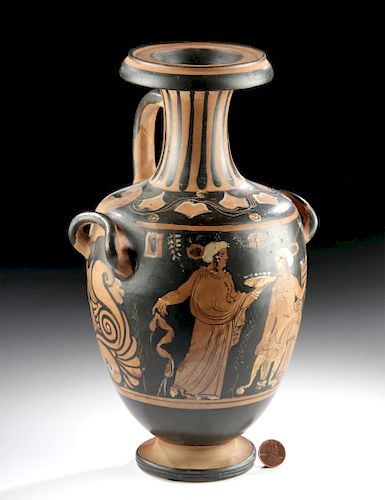Campanian Red-Figure Hydria CA Painter, ex-Royal Athena
Lot 53a
About Seller
Artemis Fine Arts
686 S Taylor Ave, Ste 106
Louisville, CO 80027
United States
Selling antiquities, ancient and ethnographic art online since 1993, Artemis Gallery specializes in Classical Antiquities (Egyptian, Greek, Roman, Near Eastern), Asian, Pre-Columbian, African / Tribal / Oceanographic art. Our extensive inventory includes pottery, stone, metal, wood, glass and textil...Read more
Estimate:
$9,000 - $12,000
Absentee vs Live bid
Two ways to bid:
- Leave a max absentee bid and the platform will bid on your behalf up to your maximum bid during the live auction.
- Bid live during the auction and your bids will be submitted real-time to the auctioneer.
Bid Increments
| Price | Bid Increment |
|---|---|
| $0 | $25 |
| $300 | $50 |
| $1,000 | $100 |
| $2,000 | $250 |
| $5,000 | $500 |
| $10,000 | $1,000 |
| $20,000 | $2,500 |
| $50,000 | $5,000 |
| $100,000 | $10,000 |
| $200,000 | $20,000 |
About Auction
By Artemis Fine Arts
Sep 26, 2019
Set Reminder
2019-09-26 10:00:00
2019-09-26 10:00:00
America/New_York
Bidsquare
Bidsquare : Exceptional Day 1: Antiquities & Asian Art
https://www.bidsquare.com/auctions/artemis-gallery/exceptional-day-1-antiquities-asian-art-4437
Day 1 of an important 2-day auction featuring exceptional, museum-worthy examples of Egyptian, Greek, Etruscan, Roman, Viking, Russian, Near Eastern, as well as Asian Art from China, Japan, Thailand, Vietnam, Burma and India. Artemis Fine Arts info@artemisgallery.com
Day 1 of an important 2-day auction featuring exceptional, museum-worthy examples of Egyptian, Greek, Etruscan, Roman, Viking, Russian, Near Eastern, as well as Asian Art from China, Japan, Thailand, Vietnam, Burma and India. Artemis Fine Arts info@artemisgallery.com
- Lot Description
Magna Graecia, South Italy, Campanian, ca. 320 BCE. Attributed to the CA Painter by Dr. Winfred van de Put, Allard Pierson Museum, Amsterdam - a beautiful red-figure hydria with an elegant form and an impressive iconographic/decorative program featuring a liberal use of fugitive/added white and yellow pigments. At the left is a woman standing in composite profile, dressed in a lovely peplos and himation as well as a kekryphalos adorning her updo, bracelets, and earrings, and holding a filet in her right hand and a patera in her left hand that is extended toward a seated bare-breasted woman who holds a basket. On the verso and under the handles is an elaborate stylized palmette motif. In addition. An ivy vine adorns the shoulder and long frets embellish the slender neck. A magnificent red-figured hydria attributed to the CA Painter. Size: 6.5" W handlespan x 11" H (16.5 cm x 27.9 cm)
The CA Painter was the primary artist of a Campanian workshop located at Cumae rather than Capua. According to A.D. Trendall, "The vases of the CA Painter tend to have a bright and rather pleasing aspect, partly due to the attractive light orange colour of the terracotta and even more to the plentiful use of added white and yellow, with occasional touches of red, for drapery or details, and to the application of a pink to red wash, which is particularly noticeable on the pattern-work … We may note, in particular, the delicacy and elegance of his drawing, both in the faces and the drapery, with its fine fold-lines in diluted glaze ..." (A.D. Trendall, "Red Figure Vases of South Italy and Sicily" (London: Thames & Hudson, 1989), pp. 167-168.
Perhaps the most exciting innovation in Greek vase painting was the red-figure technique, invented in Athens around 525 BCE and beloved by other artists of Magna Graecia. The red-figure technique allowed for much greater flexibility as opposed to the black-figure technique, for now the artist could use a soft, pliable brush rather than a rigid metal graver to delineate interior details, play with the thickness of the lines, as well as build up or dilute glazes to create chromatic effects. The painter would create figures by outlining them in the natural red of the vase, and then enrich these figural forms with black lines to suggest volume, at times perspectival depth, and movement, bringing those silhouettes and their environs to life. Beyond this, fugitive pigments made it possible for the artist to create additional layers of interest and detail, as we see in this example.
Another red-figured hydria attributed to the CA Painter realized $13,750 at Christies Sale 14572, Lot 34, 19-26 October 2016 - https://onlineonly.christies.com/s/storied-treasures-antiquities-toledo-museum-art/campanian-red-figured-hydria-34/33709
See also A.D. Trendall, "The Red-Figured Vases of Lucania, Campania and Sicily, London," 1970, pp. 81 and 137, no. 96b.
Accompanied by Royal Athena Certificate of Authenticity as well as document from The Art Loss Register dated September 19, 2005.
Provenance: private Alabama, USA collection; ex-Roy Green collection; ex-Royal-Athena Gallery, New York, New York, USA; ex-private old French collection; attributed to the CA Painter by Dr. Winfred van de Put, Allard Pierson Museum, Amsterdam
All items legal to buy/sell under U.S. Statute covering cultural patrimony Code 2600, CHAPTER 14, and are guaranteed to be as described or your money back.
A Certificate of Authenticity will accompany all winning bids.
We ship worldwide and handle all shipping in-house for your convenience.
#148740Professionally repaired from multiple pieces with restoration over the break lines, but very well done and the decorative program is still quite strong. Royal Athena label and old collection labels on underside of foot. Two felt circles under foot from former display.Condition
- Shipping Info
-
All shipping is handled in-house for your convenience. Your invoice from Artemis Gallery will include shipping calculation instructions. If in doubt, please inquire BEFORE bidding for estimated shipping costs for individual items.
-
- Buyer's Premium



 EUR
EUR CAD
CAD AUD
AUD GBP
GBP MXN
MXN HKD
HKD CNY
CNY MYR
MYR SEK
SEK SGD
SGD CHF
CHF THB
THB
















